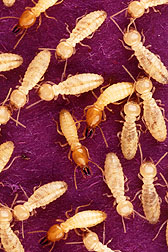This page has been archived and is being provided for reference purposes only. The page is no longer being updated, and therefore, links on the page may be invalid.
|
|
New Fungal Threat on Tap for Formosan TermitesBy Linda McElreathSeptember 25, 2000 For now, the mold growing in petri dishes at Maureen Wright's New Orleans lab is little more than a cottony patch. But termites that have died from contacting this mold have Wright considering its potential as a new bio-pesticide. Wright, a U.S. Department of Agriculture microbiologist, is charged with testing bacteria, molds and other microbes that will kill Formosan subterranean termites but spare beneficial insects. Her work is part of "Operation FullStop," a national campaign led by USDA's Agricultural Research Service against the Formosan termite, an exotic species that arrived in North America from the South Pacific sometime after World War II. In New Orleans, where Wright works at ARS' Southern Regional Research Center, Formosan termites cost the city up to $300 million annually. On Mississippi's Formosan termite-plagued Gulf Coast, ARS and other Operation FullStop scientists are testing several new pest controls, including a new bait formula containing Metarhizium anisopliae, a fungus that's approved for use in killing certain native subterranean termites. In ARS lab trials, M. anisopliae killed up to 90 percent of Formosan termites. But Wright's cottony mold, growing at SRRC's Formosan Subterranean Termite Research Unit, is even deadlier. Compared to M. anisopliae and three other fungal species tested, the mold killed 100 percent of termites in less than one week, versus 50 to 100 percent for the others in one or more weeks. The scientists' early observations indicate the termites aren't repelled by the mold (whose scientific name is being withheld for confidentiality reasons). This lack of repellency could broaden the mold's potential use in bait products similar to those that kill termites with slow-acting chemical poisons. Wright and ARS chemist Bill Connick began the tests earlier this year. They'll develop a cost-effective method for producing the mold as well as various formulations with which to apply it. Wright plans to test other strains of the mold as well. Scientific contact: Maureen Wright, ARS Southern Regional Research Center, Formosan Subterranean Termite Research Unit, New Orleans, La., phone (504) 286-4294, fax (504) 286-4419, mswright@srrc.ars.usda.gov. |


